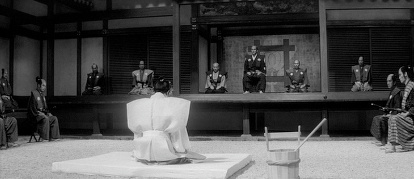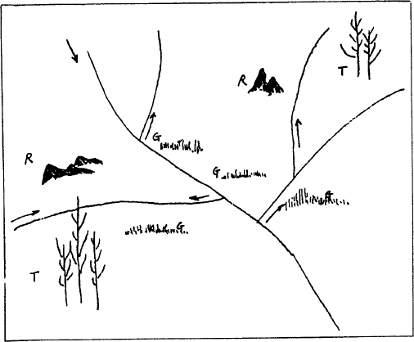Palimpsests of time and space: palpable space
Sometimes the very best essays are the ones that reveal their flaws with the greatest clarity. Cynthia Contreras’ analysis of Kobayashi Masaki’s film, Harakiri (Japan, 1962), titled “Kobayashi’s Widescreen Aesthetic”, represents a limit case in the application of some key methods of art history and the study of visual culture to the analysis of film.[1] In a lucid and scholarly account, Contreras peels back the layers of Kobayashi’s architectural sets like a palimpsest to reveal a construction of pictorial space reminiscent of what she calls an “Asian visual legacy” (p. 243) of scroll painting, Buddhist mandalas and the kabuki stage. These insights open up another world of the cultural specificity of Japanese visuality that a non-Japanese viewer may totally take for granted. However, at the same time as the reader is enlightened by these excavations, the film as a film – what brings it alive on the screen in one of the most exhilarating achievements of 1960s Japanese cinema – slips through the cracks of Contreras’ approach. Energetically, as it is lived moment by moment in its tensile performances, its volatile spatial dynamics and its poised, meticulously articulated sound track, Harakiri is a film that brings space alive, that forges its layered architectural sets in the crucible of a taut, electrifying dramaturgy into something profoundly cinematic that a visual culture analysis can never fully address. To understand how the film achieves this, we need to refigure the ways we think about space itself, to develop a performative understanding of mise en scène, and to examine the pivotal role of the film scores of Takemitsu Toru in firing this crucible.
Harakiri is a jidai-geki (period film), set in 1630, 27 years into the Tokugawa shogunate that led to the collapse of many of the feudal clans and to many ronin (masterless samurai). The film traces the revenge of the ronin Tsugumo against the Iyi clan, which had forced his son-in-law to carry through with ritual disembowelment under the most brutal circumstances. Tsugumo himself presents to the clan with a request to commit seppuku(harakiri) in the Iyi palace. As he kneels in the courtyard of the palace, he recounts the narrative that will eventually eviscerate the honour and authority of the clan. Much of the film is shot in this space of the Iyi courtyard.
Contreras argues that, in Harakiri, the organisation of space works in a symbolic way, condensing social hierarchies into physical, compositional form. She unveils a Japanese visual schema in which the spatial representation of social hierarchy has a deep heritage in the compositional techniques of mandala painting, and she reveals the highly-codified spatial configurations of feudal architecture, and the rituals enacted in these spaces, in which social relationships are mapped through the physical placement and elevation of feudal lords, retainers and others, in courtyards, palace halls and chambers. Contreras argues that the salient characteristic of the widescreen format of CinemaScope is its potential to emphasise contextuality by the location of figures within landscape or architecture. She writes, “[t]hrough careful compositional structuring, Kobayashi manages to use the contextual implications of the wide screen while creating an atmosphere of constraint as a comment upon rigid social structures” (p. 247).
When Contreras addresses the materiality of the space, she focuses on the horizontal shape of the CinemaScope frame, arguing that there are precedents in Japanese culture – notably the horizontality of scroll paintings and the “laterally elongated stage areas of both the kabuki and no theatres” (p. 243) – that rendered CinemaScope readily adaptable to Japanese visual tradition.[2] She also describes the frontality of many of the compositions in Harakiri, and the adoption of camera angles, such as the bird’s eye view, that have a strong precedent in scroll painting. One of the strengths of Contreras’s analysis is in how she unravels the way the film is played out as a concrete articulation of spatial relations, exploring how, as the film develops, the shift in camera angles to oblique perspectives and the movement of the light to form skewed diagonals and rhomboids cinematically enact the breakdown of the social order. In addition to this, she discusses a tradition of work with texture in scroll painting, evoking the integration of the materiality of the medium itself into the work – a play with the relationship between the texture of rice paper and ink – suggesting a similar heritage of self-conscious work with the relationship between texture and action in Japanese film.[3] Her analysis makes us more astutely attuned to the culturally-resonant physical structures of architecture and composition. However, the methods Contreras draws on in her analysis of space are largely those that come from a study of pictorial composition – the configuration of line, shape and tonality within the frame – that derives essentially from the study of stills. This method shackles the discussion to a way of understanding mise en scène that cannot grasp the way it functions energetically in film. The work, in this account, consists on the page or on the screen and not in the experience of the spectator. In order to understand how space actually works in the film, we need an understanding of mise en scène as something that comes into existence (uniquely) in the moment in which it is enacted, that is brought into being temporally, in the act of its unfolding and the experience of that unfolding for the spectator.
An approach to cinematic space that focuses specifically on cultural context – on its reference to cultural and aesthetic antecedents – is a precariously imprecise and blunt instrument to describe something as fluid, dynamic, and hybrid as a film, and can never fully approach the syncretic aesthetic/cinematic ideas deployed by filmmakers in their own imaginative schemas. If we start from the other direction, from inside the experience of the film, trying to understand the experiential dynamics of the film, and then seek cultural sources for this work, we arrive at a very different place. In other words, if we turn this context-based approach in film studies on its head, demanding that it answer different questions, then we come up with very different answers, answers that insist on a deeper interrogation of aesthetic concepts, structures and frameworks as they emerge in cinematic form. This requires that the analysis treat the film not as an example of a pre-existing cultural formation but as a dynamic exploration of aesthetic experience in the process of being reinvented. [4]
So how do we approach the experiential dynamics of the film? Contreras takes her core definition of the widescreen aesthetic – its emphasis on contextuality and the horizontal shape of the frame – from Charles Barr’s renowned essay, “CinemaScope: Before And After”.[5] Barr, however, declares the limitations of the focus on “the shape of the frame qua shape–as though it were the frame of a painting” (p. 9). He emphasises instead the heightened phenomenological quality of Scope, arguing that the “greater physical involvement achieved by Scope [gives us a] more vivid sense of space” (p. 11), produces “a direct sensual impression” (p. 10), which makes space more palpable. Space itself becomes pivotal in the widescreen.[6] It is this palpable quality of space that we need to address to understand Harakiri.
In fact, even when we look to other sources that explore Japanese visual culture, we can find an affinity with this approach to palpable space. Whereas Contreras evokes the tradition of scroll and screen painting for the legacy of its elongated horizontal shape, for Charles Tesson, researcher on Japanese spatiality, the painted screen is defined not by its shape but by the ambulatory vision required to view it. Tesson proposes a dichotomy between western notions of space, which he says are static, and traditional Japanese notions of space, which are dynamic. Tesson uses the example of a garden: the western garden, he writes, is a landscape to be seen; the classical Japanese garden, by contrast, is a landscape to be lived. He extends this ‘lived space’ into film, taking the cinema of Mizoguchi as his example, and argues that the primary function of Japanese spatiality is to “temporalise” space (86): space registers [enregistre] the duration and rhythm of the environment (p. 85).[7] To understand this lived space, we need a conceptual vocabulary that allows us to think time and space together.
Spaces of containment; spaces of transgression
The director, Kobayashi, refers to Harakiri as the film that ‘crystallized my aesthetic consciousness” and has marvelled at the “stellar line-up of talent” – in scriptwriting, art direction, musical composition, cinematography and acting – that made the film. Lead actor Tatsuya Nakadai describes this as a film in which nobody compromised and which “seemed to capture the feverish struggle of our three wills”, those of director, actor and the cinematographer, Miyajima. Director Shinoda Masahiro describes it as a “truly enthralling film” and critic Donald Richie recounts the first studio viewing of the film, in which “we were absolutely mesmerised by it” and acknowledges its recognition “by all Japanese critics […] as one of the finest examples of anti-samurai film ever made” (all quotes from Criterion DVD).
When I watch Harakiri, what I experience is quite a different film to the one Contreras writes about. The culturally-coded motifs of constraint and hierarchy – the symmetry and formality of the feudal geometrical schemas and the coded group formations and formulaic stylised gestures of the Iyi clan retainers – can readily be analysed for their adherence to conventions of both preceding visual traditions and of genre, but how much does this tell us about how the film works? How is this spatial configuration mobilised? These elements mark only half of a dyad. When we map out the film, follow the logic of its structure, the most striking thing is a conflict between the spatio-temporal dynamics of the clan and those of the main character, the ronin Tsugumo. The other half of the dyad, the space inhabited by the ronin, is often much more simple, sparse, minimalist – an almost abstract space – deterritorialised. The symmetry and formality that Contreras’ analysis unveils are the strand against which the whole cut and thrust of the film defines itself: these elements give Tsugumo a context to rupture, to depart from. This structural splitting between the often cluttered, decorative feudal spaces and the spare, almost abstract spaces around Tsugumo is so stark that we start to see this oscillation between the two spatial logics as the pulse, the energy motor that drives the film. It’s like a conversation between two counterpointed melodies: one heavy and familiar, constrained by convention; the other volatile, unpredictable, charged, bristling. It is this restless, driven energy that breaks out in the final scenes of the film, into the vast, agitated space of a windswept open plain and in the chaotic final confrontation, in which Tsugumo plunges through palace walls, knocking down one barrier after another, and finally demolishes the suit of armour that symbolises all of the hierarchy, tradition and authority of the clan. Through searching for evidence of how the film reveals a pre-existing cultural tradition of visual representation, Contreras misses the dynamic of the film that exceeds this logic – those things that pull against that tradition. These elements of tradition are exactly the elements that the cinematic economy of Harakiri defines itself against.[8]
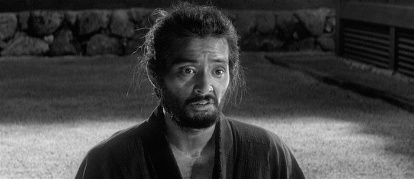 |
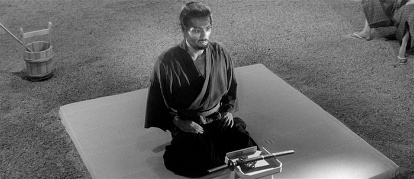 |
| “The spare, almost abstract spaces around Tsugumo” | |
Tsugumo’s presence in the film is like a rivet – he holds the centre literally, physically, in space. The voice of the actor, Nakadai, a visceral thread that runs right through the film in what he has described as a stylised ritual language of recitation, enhances this presence.[9] Nakadai’s role is also marked out spatially by the way the camera singles him out in his dark kimono against the white stones of the courtyard or the slightly out of focus beams of the wall. Tsugumo and these spaces around him are the spine of the film: these are the spaces that have all the restless energy, the charge of the film. These spaces are not without cultural coding – the clean, pure shots of the white stones, for example, are reminiscent of a Zen garden – but when you watch the film and allow yourself to be immersed in it energetically, how it works experientially, what comes to the fore is the materiality of these spaces. The space of Tsugumo becomes a saturated space of ritual intensity – a space to be registered on its own terms. It moves beyond narrative coding and becomes a volatile space.
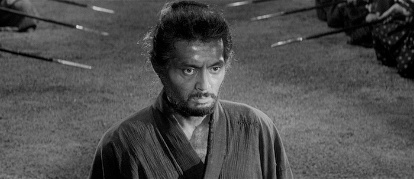 |
 |
| “Tsugumo holds the centre literally, physically, in space” | |
So how do we understand how this ritual space becomes charged? Raymond Bellour writes of moments when the materiality of space, its resonance, comes to the fore. Bellour describes mise en scène as enacting what he calls a “back-and-forth movement” (p. 115), in which figures oscillate between two functions: between functioning as an object with identity – with a narrative role, for example a space as a location or background against which the drama of characters is played out – and then functioning as pure intensity. He describes this second function as literally “figurising”: Bellour defines the first function as “external vision, what we could describe as the ‘objective status of an image/figure’”, and the second as an “‘inner vision’ that slides into its materiality, its functioning as a physical, visual body” (p. 115). He calls this “a visible spatialisation of the bodies’ relationships and of the shot’s relationships inside the scene itself” (p. 122: my translations).
Indeed, we could say that the space around Tsugumo repeatedly pulls us into this materiality: these are the spaces where this material resonance comes to the fore. When we grasp this energetic core of the film – the volatile, disruptive, deterritorialised energy around Tsugumo –the potential significance of these “figurising” aspects of the film comes more clearly into focus. Tsugumo is a ronin from Hiroshima. The space in which his recitation occurs, which he commands through sheer presence, is also, materially, a space in which his architectural, domestic and social coordinates have been erased, blurred, rendered almost amorphous, distilled into an essence of a human figure in space. A knowledge of pre-existing pictorial traditions does not in itself lead to an understanding of the potential historical currency of the film, for this is about its affect, its ability to engage the spectator affectively in a given moment, and the role of affective intensity in triggering allegorical associations that could refer to both the wartime context and the present of the early 1960s. In an interview with Kobayashi, Shinoda Masahiro specifically locates the film within the political mood of its 1962 production context: “the struggles” after the renewal of the US-Japan Mutual Security Pact in 1960 “and an unstable political climate in Japan [in which] there was a sense of despair that politics couldn’t save humanity” (Criterion DVD). This context also emphasises the resonances of the struggle between these two poles of convention and rebellion, between the spaces of hierarchical enforcement and those of transgression.
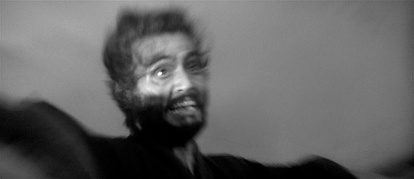 |
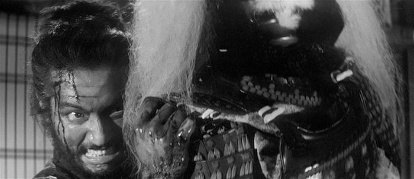 |
| “The volatile, disruptive, deterritorialised energy around Tsugumo; | |
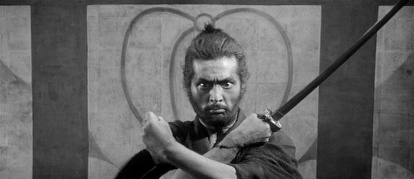 |
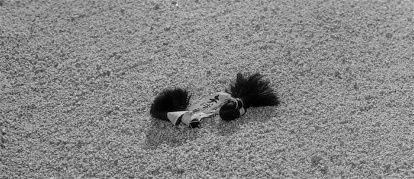 |
| “The spaces of transgression” | |
Palpable sound
While Bellour’s concept of “figurisation” offers a way to understand the materiality of space, he talks only of the image. From the very first shot of the ritual spaces of Harakiri, it becomes clear that it is not possible to separate image and sound: sound infuses the space, impregnates it. The space is volatilised as a ritual space, articulated and animated through Takemitsu Toru’s score. From the opening credits, sound adds gravitas to spaces that appear to be empty, pulling our focus into the moment in which we experience the space. In this opening sequence, the camera tracks fluidly, slowly, over the formal, architectural spaces of the palace, coming to rest in shots of rooms or murals composed in the classical symmetry that Contreras describes. This slowness and the emptiness of the space, however, do not define the shots – they work, rather, as a counterpoint to the irregular, agitated strumming of the biwa. The volume of the biwa swells and fades, the rhythm escalates and pulls back, and the tone breaks into a sour dissonance that contaminates the space, saturating it with a sense of pent-up tension lurking behind the measured control of the camera. Symmetry is jangled into rigidity, control a mask. The intensity of the music pulls us into the space, reconfiguring our experience as a dynamic engagement with the clash between the two rhythms as it crescendoes moment by moment.
This layering of sound at the outset of the film attunes us to a heightened awareness of the materiality of space. As Lucy Fisher has argued, sound more effectively produces a quality of spatiality than image does (p. 232ff.): sound produces a “palpable space”, with the potential “effect upon the audience [of] not only […] witnessing characters inhabiting a space but rather of inhabiting that space themselves, of ‘being there’” (p. 245).[10] Once the narrative begins, the first time we see the space of the courtyard laid out with the mat on which the young ronin will face his ordeal, we see two shots in quick succession: two oblique camera angles, each punctuated by a jarring single percussion sound. The sound lifts the space out of a simple representation of location, or an image reliant solely on its visual composition for its impact – the sound makes the space resonant.
 |
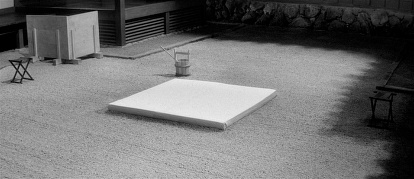 |
| “Two shots in quick succession … each punctuated by a jarring single percussion sound” | |
Sound designer Walter Murch argues that:
the most successful sounds seem not only to alter what the audience sees but to go further and trigger a kind of conceptual resonance between image and sound: the sound makes us see the image differently, and then this new image makes us hear the sound differently, which in turn makes us see something else in the image, which makes us hear different things in the sound, and so on. (Chion, p. xxii)
This resonance lifts both image and sound into a different experiential register. I would describe this process not as a “conceptual resonance” – the cognitive implications of this term do not do justice to the process – but as a material, sensory-affective resonance. Sound “figurises” the space, brings its materiality to the fore, and this materiality engages our senses and arouses an embodied, affective dimension.
Takemitsu: crossing sound with image
The acclaimed composer of Harakiri’s score, Takemitsu Toru, has written of the importance in his aesthetics of the “quality of a single sound” (1995, p. 51) and writes about how, in traditional Japanese music, the emphasis on short sounds, complete in themselves, draws attention to the experience of the present moment. Director, Shinoda Masahiro, has said that “the idea of using music in such discrete fragments … as a kind of punctuation” is rare (Richie, p. 9). Richie points out that, in Harakiri, a “single biwa chord” has what he calls a “structural integrity” because it “always occurs to signal an interplay between image and sound track” (p. 6). These single chords stir up the viewer, pulling us into a heightened awareness of the present moment, as the interplay marks moments of increased intensity and dramatic significance. Shinoda has described the score of Harakiri as “revolutionary because it showed us how image and music ought to be combined” (Richie, p. 7).
Sound and image are conventionally understood as distinct entities with fundamentally different phenomenological qualities. This distinction can only apply if we discuss film from the front-end of the production process – generating the raw materials of a shot through cinematography and sound recording. However, to understand the energetic work that sound and image do in a film, we need to grapple with the sculpting of the final film as a phenomenological totality. It is here that the space and time of a film are mapped against each other, moulded into an experiential entity. It is here that sound and image articulate each other and the separations that mark so much of our critical language into the supposed discrete entities and hierarchies of space and time, sound and image, are exposed as distinctions that become unworkable.[11]
Murch writes that, “[d]espite all appearances, we do not see and hear a film, we hear/see it” (Chion, p. xxi). Takemitsu confirms this, describing his way of working with film in which sound and image cannot be conceived separately. Judging by the synaesthetic quality of many of his statements, Takemitsu appears particularly attuned to the discovery of similarity or pattern between modes, to thinking “cross-modally”. He sees images as music: “I love movies because I experience them as music” (Richie, p. 7), and sees music as image: “when I hear sound, maybe because I am a visual person, I always have visions. And when I see, I always hear. These are not isolated experiences but always simultaneous, activating imagination” (Takemitsu 1995, p. 102). Talking of his film scores, he says, “I only add music to give the audience a little help hearing the pure music that’s already there in the images” (Richie, p. 9). Takemitsu’s score is sparse, restrained – he does not need to fill the film with music as he recognises the ‘musicality’ of the image.
This effortless slide from sound to vision, the fluidity across modes, both transforms sound and, at the same time, renders space more mobile and eloquent. Sound and image are conceived in dialogue with each other: music ‘intervalises’ space and articulates the temporality of the visual. It is this ability to think across modes that holds the key to understanding the fluidity of Takemitsu’s film score for Harakiri. Donald Richie’s explanation of this is that “Takemitsu has expressed what the images intend. He has made aural what is visible” (p. 13). However, Takemitsu’s score is of a fundamentally different quality than simply “making the visible aural”, as his music does not simply parallel the visual. What he does is to cross sound with image. The relationship between the two is conceived not as a gap or disjunction, but as an intersection or imbrication, a dynamic space of transformation. Music adds another dimension to the rhythm and temporality of a shot: it adds layers of time to a shot, breaks a shot into intervals. Movement, pace and temporality are no longer dominated solely by the movement or stasis of camera and figures: the time and space of a shot are mapped against each other in the dialogue between image and sound. Pace is as important as space and the two are indissoluble.
Nicole Brenez, in her work on performance and the role of the actor in Reservoir Dogs, talks of the “invention of montage between the acting and the image” (no pagination). She writes of the “transfer to the image of the properties of the acting […] we witness a global invention of montage between the acting and the image: their direct junction provokes a short-circuit thereby volatilizing the narrative, the dust of which is redeposited everywhere”.[12] This is exactly the conceptual tool we need to describe what happens in Harakiri – but here it is the re-invention of montage between image and sound that generates the volatility of space.[13]
A schematics of flow
Takemitsu conceives of sound as a plastic, palpable material, declaring: “I [want]to carve the sound with my own hands” (Richie, p. 10). Music is often described as a temporal art, but Takemitsu has an architectonic conception of music and of sound.[14] His writing about his compositions and film scores abounds with spatial descriptions. He writes that western music emphasises horizontality whereas, in Japanese music, the focus is on verticality – the shakuhachi, the Japanese flute, for example, “rises vertically” (1995: p. 87).[15] Sound, for Takemitsu, has a spatial density – it registers on two planes: it can move both horizontally – as a progression through time – and vertically – it can resonate in time, can amplify the present moment. Takemitsu draws on concepts from traditional Japanese aesthetics to explain this way of thinking, referring in particular to the concept of sawari: “beautiful noise” (1995: pp. 64ff).
Takemitsu describes music in terms of the spatial relationships between numbers or images that he conceives visually. He recounts how, when he composed A Flock Descends Into The Pentagonal Garden, he “made up a story, a picture, like a scroll painting” of a flock of white birds led by a single blackbird flying down into the garden (Takemitsu, Cronin & Tann, p. 208). This image became a template for the musical structure of the piece, and the blackbird became F sharp. For Arc For Piano And Orchestra, Takemitsu draws a sketch of a garden to describe the composition’s structure. Sand and clay are the strings which represent earth; rocks and stones are given “low-sounding instruments”; trees are represented by small instrumental groups, which each add layers of time (Takemitsu 1995, p. 95 ff.). The piece, he writes, follows the passage of a man walking through the garden. The man has a limp and his limping gait gives it its rhythm. Like Tesson, Takemitsu evokes the garden as a metaphor for lived space, and like Tesson, he refers to a visual image, but takes it not as static composition but as an example of mobile form. His pictures reveal a dynamic conception of space: like the notation of space-time in a musical score, they form a graph that maps space against time in a schematics of flow.

Arc For Piano And Orchestra, Takemitsu draws a sketch of a garden to describe the composition’s structure. Image reproduced from Roger Reynolds and Toru Takemitsu, “A Conversation”, The Musical Quarterly 80, no. 1 (Spring, 1996).
Space-time
To think this space-time demands concepts that cross the boundaries between these two assumed poles, that allow us to think the two together as a composite. Richie notes that, for Takemitsu, “sound can be understood at the level of images only because ‘images-words-sounds exist somewhere outside of ordinary time’” (p. 8). This conceptualisation of the nature of sound and image cannot be separated from his way of thinking about time and space. Guitarist Suzuki Daisuke claims that Takemitsu’s music is harmonically Western but his use of time is very Japanese (Hall/ABC).[16] Takemitsu is no traditionalist: he is a modern, cosmopolitan composer, who cites, as key influences on his work, John Cage, Claude Debussy, Olivier Messiaen and Duke Ellington, as well as Japanese composers such as Matsudaira Yoriaki. He writes that he was educated in Western music after World War 2 and, coming by chance to traditional Japanese music ten years later, could not approach it uncritically. However, his writing is full of a fascination with, and a close interrogation of, the aesthetic concepts of traditional Japanese music: the attempt to “study very deeply, and very carefully, the essence of traditional Japanese music, to explore unknown worlds, and to recreate, or reelucidate, in new, modern forms, what we’ve learned from our traditions” (Takemitsu 1989, p. 203). When Takemitsu talks about space, time and the image, he draws on a lexicon of traditional concepts that impregnate space with the rhythms and punctuation of time, that instil supposed stillness with movement and transformation and that saturate image with sound, and sound with image.
At the core of Takemitsu’s writings is a conceptualisation of time and space that diverges markedly from western concepts. He draws an affiliation between his work and that of architect, Isozaki Arata, who elucidates the traditional Japanese conception of space-time:
… in Japan space and time were never fully separated but were conceived as correlative and omnipresent … Space could not be perceived independently of the element of time [and] time was not abstracted as a regulated, homogeneous flow, but rather was believed to exist only in relation to movements or space …Thus, space was perceived as identical with the events or phenomena occurring in it; that is, space was recognized only in its relation to time-flow (Isozaki, cited in Pilgrim, p. 256).[17]
Isozaki claims, writing in 1979, that “[in] various fields of activity, there is a significant parallel between this traditional interpretation of time-space and the contemporary orientation to the same concept” (p. 70). An exploration of the historical context which led to a broader revival of interest in traditional aesthetic forms and concepts in the 1970s is beyond the scope of this essay; however, it is pertinent in this context that Takemitsu talks at length about his own attempts to “[cultivate] within my own sensitivities those two different traditions of Japan and the West” (1995, p. 520), to produce something that he calls a “universal egg” (Takemitsu 1989, p. 200): music that is “not ‘Japanesey’ in any way … [but] is ‘influenced by, immersed in the Japanese musical tradition’” (p. 203).[18] He says, “I think there are things which are perhaps very different from Western music – a sense of time, a sense of space, and a sensitivity to color and tone” (1989, pp. 202-3).
Central to Takemitsu’s own writing about the question of time and space is the concept of ma. The Noh scholar, Komparu Kunio, describes ma as “a unique conceptual term, one without parallel in other languages … because it includes three meanings, time, space and space-time” (Pilgrim, p. 257). The concept is loosely translated as “a pause, or interval”, which, as Hilary Tann says, is fundamentally different to “the Western concept of a rest, a silence, which can often mean emptiness” (Takemitsu, Cronin & Tann, 1989, p. 212). It is often described as ‘a pregnant pause’: what Roger Reynolds calls a “jostled silence” (Reynolds 1992), or as Takemitsu describes it, a rich, resonant silence (Takemitsu 1995, p. 51). Takemitsu writes:
A single strum of the [biwa] strings or even one pluck is too complex, too complete in itself to admit any theory. Between this complex sound – so strong that it can stand alone – and that point of intense silence preceding it, called ma, there is a metaphysical continuity that defies analysis … this ma and sound do not exist as a technically definable relationship. It is here that sound and silence confront each other. (Takemitsu 1995, p. 51)
When Takemitsu describes the relationship between these “short fragmented connections of sounds”, and the silences that separate them, he says “there is a dynamic change in the sounds as they are constantly reborn in new relationships” (Takemitsu 1995, p. 84).
Takemitsu describes ma as “living space, more than actual space” (Takemitsu, Cronin & Tann, p. 213).[19] In Richard Pilgrim’s account, too, the immediacy of the present, the moment of experience is paramount:
[ma] is a way of sensing that points to the fullness of the present moment in its intuitive, aesthetic immediacy as the locus of living reality – an experience consonant with the ancient Japanese poetic awareness of time/space collapsed in the present moment” (p. 270).
To Isozaki, “[ma] is the way to sense the moment of movement” (p. 78). This is a concept of experiential space – the way we inhabit space. Beyond the physical level, it is space subjected to the transformations of time through duration.
As Pilgrim explains, ma is akin to an interval (pp. 267ff.), and this is the key to thinking about Takemitsu’s work with space and time and with sound and image.[20] For Takemitsu, ma transforms the relationship between space and time, and that between sound and silence.[21] Takemitsu again evokes Isozaki, and emphasises that this gap or interval is understood relationally: that ma is transformational. Isozaki sheds some light on this transformational nature when he links the concept of ma to the practice, in traditional Japanese culture, of setting up:
sanctified places (yorishiro) … sometimes delineated by the setting up of four posts, one in each of the corners … or by marking off the area with a simple rope … kami [divinities] were believed to descend to fill these voids with spiritual force (chi) […]. The very acts of preparing such a space and waiting for kami to descend into it had immense influence on later modes of space-time cognition (p. 71).
After reading Isozaki’s description, it is hard not to see traces of this practice of preparing a ritual space of transformation in the construction of the courtyard in Harakiri. The space in which Tsugumo sits is demarcated visually by a white square mat in the centre of the stones. Aurally, the first time we see this space after the opening credits, it is punctuated, marked, intensified by the sudden, aggressive, single strikes of the biwa. This discordant music singles out the space as more than just a physical space, more than an empty space: it is saturated with a hidden intensity. Takemitsu is a master of this selective charging of particular spaces with sound. In The Face Of Another (Teshigahara Hiroshi, Japan 1966), for example, he selects the layered, textured image-space of the doctor’s laboratory, where a Frankenstein-like facial transformation will take place, as the space in which sound ripples and breaks out, in clear contrast to its absence in the domestic scenes. We could say, perhaps, that it gives the space a timbre.
Isozaki’s account suggests a conceptual underpinning to this spatial construction that potentially explains the idea behind working in this way and, indeed, gives us a way to think about how this space becomes volatile.
What Murch calls a “conceptual resonance” and I would call an “affective resonance”, perhaps Isozaki would call a “spiritual resonance”. Each concept gives the process a different inflection, but each attempts to articulate the way a space becomes charged, becomes more than the empirically available image, and to think about image-sound relations as a way of awakening and harvesting that something else, elevating the ensemble to another level. Sound imbues the space with a significance beyond the physical (empirical) space represented – a ritual dimension, a heightened intensity. It pulls us into the cinematic materiality of the present moment in a process by which we are drawn into an experience of heightened embodied affect. Space is not just visual or aural; it is corporeal. It is experienced in a fully embodied way, through the ‘thickness’ of the body. Furthermore, this intensity accrues, accumulates – once we’re tuned into the saturation of the space, that alertness fills the way we watch and engage with the film. A shot, in other words, contains movement and energy that come not only from the present moment, but also from the accumulated sensory awakening and intensity set up by previous moments. A space is not simply a physical space, an actual space with physical correlates – it has affective correlates. It pulls us into the sensory moment but that immediacy is not only present: all of the past moments also exist in the present. It is a space laced with sensory-affective memory.
In film this does not happen simply through the positing of, or marking out of a space – an allusion to another space, another practice. It happens through the work of the film, enacted in the dialogue set up between sound and image. This is put in place on the level of the senses – the awakening of the sensory experience of the spectator to a heightened mode of mimetic perception – a proximity, a sharpened engagement with the moment of experience as it is unfolding. It is an attunement with the pulse of the film flipping from dimension to another, with a mimetic understanding that the energetic dynamism of the film can pass effortlessly from sound to vision, that a space is saturated with time, that the units by which a scene is constructed are the cinematic in its totality. Perhaps we could call this something like a ‘cineme’: a cinematic moment experienced in space and time through a sound-image collaboration in conjunction with the accumulation of the memory of all such units previously encountered in the film and the accrual of narrative associations, as they are experienced by the spectator. This is the unit of cinematic experience.
A material contagion
In his version of the evolution of the sound film, Gilles Deleuze writes of the transformations that produced modern cinema, which, as he sees it, broke what was previously a unity between sound and image, producing instead two heterogeneous materials or entities – sound and image – and a cinema in which the autonomy of the two and the dissonance between them is paramount (pp. 241ff).[22] Kobayashi’s film, however, departs from the classical assumption of the unity of sound and image, without following the precepts of the European modernists, with their heritage in an avant-garde that would focus on the disjunctive potential of bringing together two heterogeneous materialities. In Harakiri, sound and image retain their heterogeneous materialities but those materialities are held in a dialogue with each other, as if one energy or impulse is passed back and forth between image and sound and the energy erupts in the space, the interval between them – across the gap – in a kind of relay between the senses. A sensation, an intensity, a narrative pivot, simmers in the image and is then flicked over from one sensory medium to another – from image to sound and back again – so that, as viewers, we are flipped between visual and aural, between the different registers, in a relay, awakening one sense and then the other.
This sensory ‘flipping’ is nowhere more evident than in the duel fought on the plain. The camera cuts from the open space of a windswept plain, held down by ominous dark clouds, to close-ups of grass beaten down, driven in every direction by the frenzied force of the wind. Contreras writes that the final duel “takes place in the grass”, but this grass is in no way simply an inert background. The rippling, bristling grass “figurises”, comes forward as a material entity in the shot, and brings out the bristle in the poise of the samurai – the rhythm and agitation of the wind are carried over into the bodies of the samurai. This is not a metaphor – it is a material contagion. The grass in turn takes on the agitation, the ripple, as if it is a muscular spasm that flicks across from the poised bodies of the samurai. The image also cannot be understood without reference to the sound. The howl of the wind pulls our attention into the grass, the rippling close-ups that agitate the whole shot, spreading the texture of chaotic movement across and beyond the frame. In a film with very few diegetic sound effects, suddenly the insistent presence of the wind in the grass, a scratchy aural close-up, impinges on the viewer in its haptic proximity. Into this cacophony of rhythms – the rustling and rippling grass, the howling wind, swirling mist and clouds and the poised choreography of the samurai – cut the strumming, striking and tremolo plucking of the biwa. To know Harakiri is to be in awe of the dramaturgical quality of this instrument, the way its high frets and loose strings allow the sound of a single strum to degrade and decay through unpredictable, undefinable transitions that can only be grasped once they are complete.[23] The biwa rivets the viewer into the quality of the sound itself, the ‘sawari’, its emotional resonance, as it jars and jangles the space. The grass figurises; sound figurises.
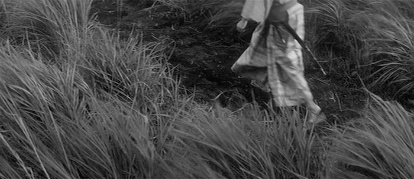 |
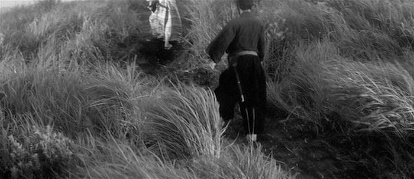 |
| “This grass is in no way simply an inert background” | |
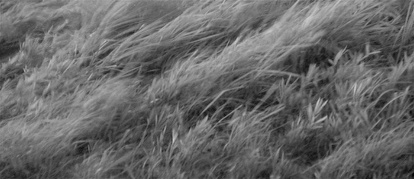 |
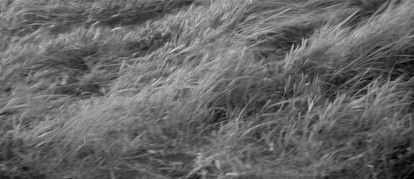 |
| “The rippling close-ups that agitate the whole shot” | |
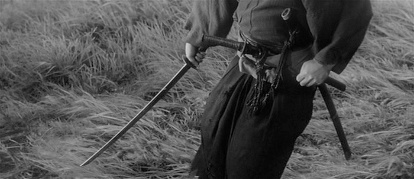 |
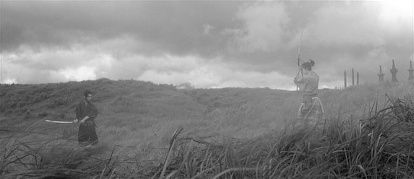 |
| “The rippling, bristling grass “figurises” … brings out the bristle in the poise of the samurai” | |
The film has set up the expectation that sound punctuates pivotal moments, flipping them onto another register. The aural rhythm has been set up in the preceding shots as the samurai walk through the cemetery, as a repeated motif of beats is counted out in the music, followed by the whooshing howl of the wind. As soon as the samurai step onto the plain, the music cuts out, yielding to the sound effects of wind and footsteps, but the rhythmic beat continues in the choreography as the samurai step out three steps and pause, three steps and pause. The aural close-up of the wind rustling through the grass carries over the rhythmical structure of the music, as its volume rises and falls, pulling in and out, in mimicry of the crescendos in the earlier music. It will be almost three minutes before the biwa suddenly breaks back into the scene; for three minutes the focus is on the rhythms of the choreography. This is a choreography not only of the bodies of the samurai but of every other element of the mise en scène. Adrian Martin has written of cinematic moments when the “energies of bodily performance, of gesture and movement collide willy-nilly … with the figurative work of shooting, framing, cutting, sound recording” (cited in Islam, no pagination). Martin writes of the performing bodies of actors, but here it is also the multiple cinematic ‘bodies’ that perform: the cinematic body of the rippling grass, the body of the swirling mist, of the gathering clouds, of the clashing swords, of the horizon tilting precariously, the body of the scraping grating wind sounds in the grass and, as the music comes in, the cinematic body of the biwa and the percussion instrument with their jangling, aggressive posturing. All are choreographed against/collide with the performing body of the camera as it plunges into ever more oblique angles. The intensity of the scene is held here in sound, there in image; here in bodies, there in wind; here in space, there in pace. This is what it means to have a performative understanding of mise en scène: to understand that pictorial composition is but one dimension of the complex, dispersed rhythms and intensities of sound and image. Kobayashi and Takemitsu work with the divergent material properties of sound and image but bring them together, in dialogue. While they retain their heterogeneous materiality, the senses which they bring alive are harvested into one aesthetic energetic impulse.
The best model we have to describe this process is Eisenstein’s concept of polyphonic montage. In formulating his conception of montage, it is no coincidence that Eisenstein turned to traditional Japanese theatre for inspiration. He evoked the kabuki actor, Shocho, describing the way the actor performs in a body in fragments, which he called “disintegrated acting”:
[Shocho […] performed his role in pieces of acting completely detached from each other: Acting with the neck and head only. (The whole process of the death agony was disintegrated into solo performances of each member playing its own role: the role of the leg, the role of the arms, the role of the head). A breaking up into shots. With a gradual shortening of these separate successive pieces as the tragic end approached: … by this method, the actor is enabled to fully grip the spectator by ‘rhythms’ (Eisenstein, 1930, p. 43).
Eisenstein describes this as a kind of relay – passing the baton from one element to another, or like a soccer team passing the ball back and forward as they run. This becomes a key model for his concept of polyphonic montage; he writes of film as a symphony, and envisages a film score like an orchestral score on which are plotted the complex articulations of “figuration, montage, sound, color, etc”, as Jacques Aumont writes (Aumont 1987, p. 185). Aumont describes Eisenstein’s vision of a polyphonic montage in which all of the “various audio-visual elements have ‘equal rights’” (p. 185), and writes that:
Eisenstein goes as far as to imagine a completely new ‘mixture’ of all the stages at the same time – instances, for example, where the function of figuration would be assumed by the music, and where the visual elements would construct the global image from this figuration (Aumont, p. 183).
The influence of traditional Japanese aesthetics added depth and subtlety to Eisenstein’s understanding of montage. As Michael Taussig writes, this heritage fed into Eisenstein’s thinking about the physiological dimensions of cinematic affect (Taussig, p. 28).[24]
Again and again, Eisenstein’s statements about the sound film echo the synaesthetic schemas of Takemitsu. He writes of “finding an inner synchronization between the tangible picture and the differently perceived sounds” (Leyda, 1943, p. 70); of “a perception of the pieces (of both music and picture) as a whole” (Leyda, p. 73). He refers to jazz as a model which, he says, “doesn’t employ voices with accompaniments, similar to figures against the background. Everything works. Each instrument performs its solo while participating in the whole” (Leyda, p. 82). In “The Unexpected”, he writes of the method, in kabuki, “in place of accompaniment [of] transferring the basic affective aim from one material to another, from one category of “provocation” to another (Eisenstein 1928, p. 21). One must, he writes, “develop in oneself a new sense: the capacity of reducing visual and aural perceptions to a ‘common denominator’” (p. 24). The core of the connection he sees between film and kabuki is the “non-differentiation of perception” (p. 26): “the unexpected junction … of non-differentiated sense ‘provocations’ of kabuki on one side, and on the other – the acme of montage thinking” (p. 27).[25]
Recent debates on synaesthesia are probably the closest approximation we have to articulating how this ‘flipping’ occurs, but Harakiri demonstrates the potential of cinema to produce modes of experience that are more than simply cross-modal experience – experiencing one sense as the other or complemented by the terms of the other. This is of a different order: this is not just sound as image or vice versa. It is a recognition that the ways we watch and experience film are much more fluid, more flexible than any analysis of sound or image as separate modalities could encompass. It is a recognition that a musical beat, for example, can evoke rhythmic patterns that can then be taken up as the rhythmic beat of an image in a recognition of mimetic similarities: that agitated grass can fracture the plane of the image, ‘grating’ the visual field such that, when the biwa comes in, it can catch that discordant grating and amplify and spread it, fling it onto the body of a samurai; just as Shocho could act with one element then another to produce what Eisenstein calls a “monistic ensemble” (1928, p. 20), so can a scene disperse its intensities across the whole cinematic system to awaken the full mimetic experience of the viewer.
It is most likely that Takemitsu was familiar with Eisenstein’s theoretical work on montage, given the long history of interest in Eisenstein’s work in Japan, dating back to both personal and intellectual exchanges in the Taisho era, when his work was translated and vigorously debated in the context of Japanese left-wing artistic movements. There were also extensive debates on Eisenstein in avant-garde circles in the 1950s and 1960s.[26] Given that several of Takemitsu’s key film collaborators had a vital interest in Eisenstein’s ideas, it seems that Takemitsu’s understanding of his film scores could not be uninfluenced by these debates on Eisenstein’s seminal theorisation of the nature of audio-visual counterpoint in the sound film, which in turn drew on the Russian’s encounter with kabuki.[27] Indeed, Takemitsu’s transformational conception of the relationships between two entities has a close affinity with the concept of montage – an understanding of how to mobilise the interval as a transformative moment – and resonates strongly with Eisenstein’s synaesthetic aspirations for cinema. His contemporary “reelucidation” of ma as an aesthetic foundation for the conceptualisation of audiovisual space-time relationships in his film scores speaks to a highly syncretic reinvention of audiovisual montage as a model that has flipped back and forth across the plains of Siberia over decades of cultural cross-fertilisation. The concepts Takemitsu evokes from traditional Japanese aesthetics give us another way to think this fundamental principle – that space and time are not separate (space is temporal/ lived); that sound and silence are not opposites (jostled silence); that image and sound can be thought as mimetically similar – of the one impulse.
Space and time; Stillness in motion
To come back to Contreras: Contreras does not ignore the question of time. She writes that “[u]ltimately [Harakiri] is about the interaction of time and space” (p. 259). However, her conception of time and space and how they function in mise en scène cannot grasp these dynamic energies of the film. When she writes of the interplay between the visual parameters and the action and figures, Contreras describes this dynamic as two axes in the film: static space and moving time. She sees space and time as two poles articulated against each other in a dichotomy between composition and choreography and between stillness and motion. She says:
space becomes the stable context for people and objects. It is given three-dimensional depth through architectural arrangements and through the movement of the characters and the camera. Dynamism is provided by the temporal forces of movement and montage, which penetrate and alter the serene spaces (p. 259).[28]
Space, in other words, has symbolic resonance but, materially, is inert, except where movement is articulated by the displacement of figures and the shifting composition of light and camera angle. However, this dichotomy is in Contreras’ conceptual vocabulary, rather than in the film itself: motion and stillness here play out rather differently than a dichotomy between two poles of time and space. Whereas Contreras argues that Kobayashi counterposes movement and stasis, I would argue that the film works, rather, with the movement in stasis. The only way we could describe this as static space is to marginalise time from our understanding of mise en scène, for casting a shot composition into the flow of time, the pressures exerted by time, is to cast it into the process of its own transformation.
The implications of Contreras’ separation of time and space, evident in her account of the shots in which the camera and figures rarely move, are thrown into stark relief in its application to the action sequences. It is with the duel scene that Contreras’ discussion of the film reveals most clearly the inadequacy of its pictorial approach to address the dynamism of the film or to give an insight into why it is so thrilling. Contreras describes the diagonal lines which the figures of the samurai make with their bodies and swords against the horizon:
The stylised duel … takes place among wind-blown grasses against a stark open landscape … Diagonal forms are emphasised throughout the scene in the line of the sloping land behind them, a sword slanted across the frame, the placement of characters in opposite corners of the screen, and in the frequent use of oblique angles. The diagonal line as a compositional force has long been significant in Japanese painting […]
A particularly dramatic use of the diagonal line comes during a series of shots in which Omodaka is advancing on Tsugumo … An oblique angle is used, and Tsugumo is seen in a medium-full shot in the center of the screen with the horizon cutting a diagonal from the lower left to the upper right corner. The camera moves slightly closer as Tsugumo extends his arm so that the sword reaches horizontally across and beyond the screen frame on the left. He then raises his sword into a diagonal line with the tip touching the upper left corner. This diagonal is completed by the downward line of his other arm toward the lower right corner. The background diagonal, the line of his arms and sword, and the oblique angle combine to suggest an invincible warrior. This shot makes full use of the widescreen dimensions (p. 256).
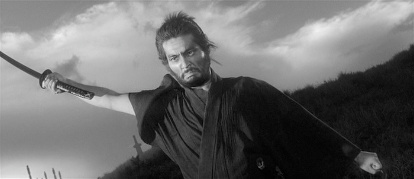 |
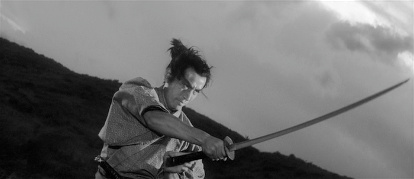 |
| “Diagonal forms are emphasised” | |
To be sure, the shots are composed on diagonals, but can diagonal composition and the canted camera angle explain how we can feel invigorated, poised on the edge of our seats, holding our breath, senses alert, bristling, electrified by this scene? In Contreras’ account here, movement is conceived almost like flip cards – a shift from one fixed composition to another – at least in this description. Hence the end-point of a sequence of movement, which results in a diagonal composition, is seen to shift to the next end-point – the next diagonal – as if these are frozen moments. The transitions between the fixed poses – the movement itself – appear inconsequential, as is the tremulous disequilibrium – what Alexandre Astruc calls “plastic fatalities” – that continues at these supposed end-points – the accumulation of tensions within and between shots that prefigure and threaten their dissolution.[29] In the cut and thrust of the duel, poses are not so much held as poised, taut, ready to strike; the momentum of the scene is driven not by stasis but by the kinetic energy that bristles and builds with every poised gesture. The strike is contained in the pose, like the cobra, and in the total composure and inner stillness, clarity or precision that animates and underpins the choreography. This is different to figures in painting and we need an entirely different conceptual tool-box to understand it. Indeed, we need to look to traditions of thinking about bodies in space – the kinaesthetic traditions of dance or dramaturgy – for methods of analysing this motion in stasis.[30]
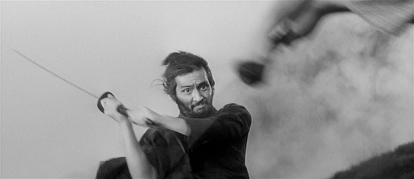 |
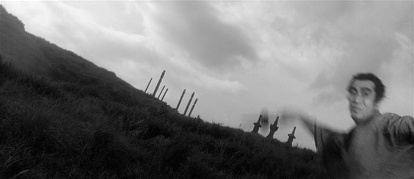 |
| “The momentum of the scene is driven not by stasis but by the kinetic energy that bristles and builds” | |
Wong Kin-Yuen has written of a motion/stillness dialectic in action cinema but in a way that emphasises, following Deleuze, that “all images are thought of as moving images” (p. 279). Evoking David Bordwell’s idea of the “burst-pause-burst action” of kung fu films, he discusses the concept, in Chinese aesthetics, of “being very ‘still’ to the naked eye, but in fact, full of intense energy”, and evokes “the kung fu idea, based on Daoism, of ‘gathering up your shi to a bursting point’” (Morris ed., p. 278).[31] Wong writes, “the idea is that crouching within things or matter which are supposed to be still are dynamic forces of intensity, ready to burst out at a moment of utmost disequilibrium” (p. 278).[32] This is a vital concept for thinking about the energy and dynamism of the spaces of Harakiri, in which very little moves physically but the space-time simmers, builds the intensity of the space to an unbearable tension. In order to understand the nature of cinematic bodies in cinematic space, we need to understand it experientially, kinaesthetically, and to integrate the temporal into that understanding.
In order to fully understand the implications of this, we need to integrate into our way of thinking about filmic space the implications of several decades of work on spectatorship. We need to shift our understanding of film off the exclusive focus on the screen and into the experiential moment. It is not adequate to talk about the “representation of” space, as if it is a question of representation – it is, by definition, a question of experience, in particular the materiality of that experience: it is embodied. In the duel, the tension is not only in a contrast between the lines of the frame and those within the frame. The tension lies in us, as spectators, between our sense of equilibrium and its skew in the image. It is not only the image that threatens to fall over but we also who are teetering on the edge. Because we know the symmetry, the balance and equilibrium of the quadrilateral, the diagonal skews us to lose balance. Our conceptual approaches need to find ways to hold together, in the one frame, these two dimensions the textual and the experiential.
The mathematics of cinematic polyphony
What does it mean to posit sensory experience as a relay across the senses? This suggests an understanding of perception not as a conglomeration of five discrete senses but as a complex, fluctuating mosaic of sensory memory, templates that match sense and affect, fragments that come to the fore to process certain contexts, certain images and then recede and lie dormant or resonate lightly while other saturated fragments take on the front line of perceptual contact. This is not a claim at a scientific model of perception; it starts from experience and works backward to try to find a way to formulate how these experiences of moments of saturated intensity seem to work. We could say that we perceive and engage with bristling things in the part of us that bristles, that we perceive tight things with the part of us that knows constraint, and expansive things with the part of us that opens out in a more expansive way. Our reception/perception is woven from these fluctuating articulations of affect and mimetic experience, in much the same way as we could say that sounds vibrating at a certain frequency evoke a sympathetic vibration in substances that have the right vibratory range.[33]
Takemitsu writes: “Stones may appear silent, but in relationship to their surrounding they seem to be conversing” (Takemitsu 1995, p. 121). It takes a composer who understands the way stones speak to know how to invent ways of working with the musicality of architecture – to enter inside the mise en scène and set up a conversation between the physical, plastic space of sets, the resonant space of sound and silence, the spatio-temporal fluidity of the camera and the flow of experiential time as the film moves forward. It is this perception of similarities between image and sound, between space and time, and between sound and silence that encapsulates the transformational nature of Takemitsu’s work on his film scores: his transmutation of space into patterns of mimetic awakening.
Walter Murch once described cinema as “stumbling around in the ‘pre-notation’ phase of its history” (Ondaatje, p. 50). He said:
I think cinema is perhaps now where music was before musical notation […] was invented […] when modern musical notation was invented, in the eleventh century, it opened up the underlying mathematics of music, and made that mathematics emotionally accessible. You could easily manipulate the musical structure on parchment and it would produce startlingly sophisticated emotional effects when it was played. And this in turn opened up the concept of polyphony – multiple musical lines playing at the same time. Then […] music really took off. Complex and emotional changes of key became possible across the tonal spectrum … (Ondaatje, p. 50).
Eisenstein’s model of film as a symphony and Takemitsu’s schematic diagrams of space-time flow gesture towards the desire for this kind of notation. While it may never be achieved– or perhaps even desirable – this vision opens up the possibility of a polyphonic conceptualisation of cinema, in the manner of an orchestral score, as an attempt to map sound and image in the space-time of cinematic experience. It holds out the promise that this conceptualisation itself could open up the sensory-affective dynamics of cinema and elevate them to their rightful place as the phenomenological pulse of cinematic experience.
Works Cited
Anderson, Joseph L. & Donald Richie, The Japanese Film: Art And Industry (Princeton: Princeton University Press, 1982).
Astruc, Alexandre, “Le Feu Et La Glace”. Cahiers Du Cinéma 18, December 1952, cited in Lutz Bacher, The Mobile Mise En Scene: A Critical Analysis of The Theory and Practice of Long-Take Camera Movement in The Narrative Film (New York: Arno Press, 1978).
Aumont, Jacques, Montage Eisenstein. Trans. Lee Hildreth, Constance Penley and Andrew Ross (London: BFI; Bloomington & Indianapolis: Indiana University Press, 1987).
Aumont, Jacques ed., La Mise En Scène (Bruxelles: De Boeck Université, 2000).
Barr, Charles, “CinemaScope: Before and After”, Film Quarterly 16, no. 4 (Summer, 1963), pp. 4-24.
Bellour, Raymond, “Figures Aux Allures De Plans”. Jacques Aumont ed. La Mise En Scène (Bruxelles: De Boeck Université, 2000).
Bordwell, David. Planet Hong Kong: Popular Cinema and the Art of Entertainment (Cambridge, Mass. & London: Harvard University Press, 2000).
Brenez, Nicole, “The Actor in Place of the Edit”. Transl. Fergus Daly. Senses Of Cinema no. 21 (2002). archive.sensesofcinema.com/contents/02/21/contents.html Accessed 1.3.2003. No longer available on this site.
Burch, Noel, To The Distant Observer: Form and Meaning in the Japanese Cinema (Berkeley: University of California Press, 1979).
Chion, Michel, Audio-vision: Sound on Screen, ed. and transl. Claudia Gorbman (New York: Columbia University Press, 1994).
Contreras, Cynthia, “Kobayashi’s Widescreen Aesthetic”, in Cinematic Landscapes: Observations on the Visual Arts and Cinema of China and Japan, ed. Linda C. Ehrlich and David Desser Austin, Texas: University of Texas Press, 1994).
Deleuze, Gilles, Cinema Two: The Time Image, trans. Hugh Tomlinson and Robert Galeta (Minneapolis: University of Minnesota Press, 1989).
Desser, David, Eros Plus Massacre: An Introduction to the Japanese New Wave Cinema (Bloomington: Indiana University Press, 1988).
Eisenstein, Sergei, “The Unexpected” (1928); “The Filmic Fourth Dimension” (1929); “The Cinematographic Principle and the Idiogram” (1930), in Film Form: Essays in Film Theory, ed. and transl. Jay Leyda (New York: Harcourt, Brace & World, 1949).
Eisenstein, Sergei, “Synchronisation of Senses”, in The Film Sense, ed. and transl. Jay Leyda (London & Boston: Faber and Faber Ltd., 1943).
Fischer, Lucy, “Applause: The Visual and Acoustic Landscape”, in Film Sound: Theory and Practice, eds. Elisabeth Weis and John Belton (New York: Columbia University Press, 1985).
Gerow, Aaron, “Documentarists of Japan #9” www.art.nihon-u.ac.jp/jasias/iconicsje1-20.html Accessed 2 Apr. 2010.
Grilli, Peter, “The Spectral Landscape of Teshigahara, Abe, and Takemitsu”,http://www.criterion.com/current/posts/607-the-spectral-landscape-of-teshigahara-abe-and-takemitsuAccessed 2 April 2010.
Isozaki, Arata, “Ma: Japanese Time-Space”. The Japan Architect 54 (February 1979), pp. 69-81.
Iwamoto, Kenj, Film Criticism and the Study of Cinema in Japan: A Historical Survey,http://www.raizofan.net/eng/history1.htm Accessed 2.5.09; originally published in Iconic 1 (1987), Japan Society of Image Arts and Sciences.
Iwasaki, Akira, Eiga To Shihonshugi (Film and Capitalism) (Tokyo: Sekaisha, 1931). Prewar proletarian film movements collection. The Center for Japanese Studies Publications Program electronic publications; Univ of Michigan Ann Arbor, http://www.umich.edu/~iinet/cjs/publications/cjsfaculty/filmprobooks.html Accessed 2.5.09.
Kato, M. T., From Kung Fu to Hip Hop: Globalization, Revolution, and Popular Culture (Albany: Suny Press, 2007).
Koozin, Timothy, “Traversing Distances: Pitch Organization, Gesture and Imagery in the Late Works of Toru Takemitsu”, Contemporary Music Review 21, no. 4 (2002), pp. 17–34.
Lamarre, Thomas. Shadows on the Screen: Tanizaki Jun’ichirô On Cinema And “Oriental” Aesthetics, Michigan Monograph Series in Japanese Studies (Ann Arbor, MI : Center for Japanese Studies, University of Michigan, 2005).
Matson, Yuji, The Word and the Image: Collaborations Between Abe Kôbô and Teshigahara Hiroshi, MA thesis, Department of Pacific and Asian Studies, University of Victoria, 2007, http://hdl.handle.net/1828/301 Accessed 1.7.2009.
Murch, Walter. “Foreword”, in Michel Chion, Audio-vision: Sound on Screen, ed. and transl. Claudia Gorbman (New York: Columbia University Press, 1994).
Nakamura, Prof. Koichi and Mrs. June H., “The Japanese Literary and Theatrical Tradition in Eisenstein’s Theory of Montage and His Films”. Summary of the June 12 Lecture. http://www.tiu.ac.jp/~bduell/ASJ/6-95_lecture_summary.html Accessed 2.5.09. Adapted from The Asiatic Society of Japan Bulletin No. 7 (September 1995), compiled by Hugh Wilkinson.
Needeya, Islam, “The Cinematic Life of Emotions: John Cassavetes: Interview With George Kouvaros”, Senses Of Cinema 2000.
archive.sensesofcinema.com/contents/00/5/emotions.html
Nygren, Scott, Time Frames: Japanese Cinema and the Unfolding of History (Minneapolis: University of Minnesota Press, 2007).
Odin, Steve, “The Influence of Traditional Japanese Aesthetics on the Film Theory of Sergei Eisenstein”, Journal of Aesthetic Education 23, no. 2 (Summer, 1989), pp. 69-81.
Ondaatje, Michael, The Conversations: Walter Murch and the Art of Editing Film (London: Bloomsbury, 2002).
Pilgrim, Richard B., “Intervals (‘Ma’) in Space and Time: Foundations for a Religio-Aesthetic Paradigm in Japan”, History of Religions 25, no. 3 (Feb., 1986), pp. 255-277.
Reynolds, Roger and Tõru Takemitsu, “A Jostled Silence: Contemporary Japanese Musical Thought (Part One)”, Perspectives of New Music 30, no. 1 (1992), 22-35.
Reynolds, Roger and Toru Takemitsu, “A Conversation”, The Musical Quarterly 80, no. 1 (Spring, 1996), pp. 61-76.
Richie, Donald, “Notes on the Film Music of Takemitsu Toru”, Contemporary Music Review 21 (2002), no.4, pp. 5-16.
Rutherford, Anne, “Nowhere to Hide: The Tumultuous Materialism of Lee Myung-Se”, in Seoul Searching: Culture and Identity in Contemporary Korean Cinema, ed. Frances Gateward (Albany: SUNY Press, 2007).
Sato, Tadao, Currents in Japanese Cinema (Tokyo: Kodansha International, 1982).
Shinoda Masahiro, Eizenshutein (T?ky? : Iwanami Shoten, 1983),http://www.worldcat.org/title/eizenshutein/oclc/41094909&referer=brief_results Citation accessed 2 April, 2010.
Takemitsu, Toru. “Contemporary Music in Japan”, Perspectives of New Music 27, no. 2. (Summer, 1989), pp. 198-204.
Takemitsu, Toru, Tania Cronin and Hilary Tann. “Afterword”, Perspectives of New Music 27, no. 2. (Summer, 1989), pp. 205-214.
Takemitsu, Toru, Confronting Silence: Selected Writings, eds. and trans. Kakudo, Yoshiko and Glenn Glasow (Berkeley, Calif.: Fallen Leaf Press, 1995).
Taussig, Michael, Mimesis and Alterity: A Particular History of the Senses (Routledge: New York & London, 1993).
Tesson, Charles, “La Spatialité Japonaise”, in La Mise En Scène, ed. Jacques Aumont (Bruxelles: De Boeck Université, 2000), pp. 85-97.
Wong, Kin-Yuen. “Technoscience Culture, Embodiment and Wuda Pian”, in Hong Kong Connections: Transnational Imagination in Action Cinema, eds. Morris, Meaghan, Siu Leung LI, and Stephen Chan Ching-kiu (Durham: Duke University Press; Hong Kong: Hong Kong University Press, 2005).
Films
Assassination (Ansatsu), dir. SHINODA Masahiro, Japan 1964.
Harakiri (Seppuku), dir. KOBAYASHI Masaki. Shochiku Co., Ltd., 1962.
The Face of Another (Tanin No Kao), dir. TESHIGAHARA Hiroshi, 1966.
Samurai Rebellion (Joi-uchi), dir. KOBAYASHI Masaki, Japan 1967.
Seven Samurai (Shichinin No Samurai), dir. KUROSAWA Akira, Japan 1954.
Double Suicide (Shinju Ten No Amijima), dir. SHINODA Masahiro, Japan, 1969.
Woman of the Dunes (Suna No Onna), dir. TESHIGAHARA Hiroshi, Japan 1964.
Eros Plus Massacre (Eros Purasu Gyakusatsu), dir. YOSHIDA Yoshishige, Japan 1969.
Toru Takemitsu: Music For The Movies. Directed by Charlotte Zwerin. New York, NY: Sony classical film & video. Produced by Margaret Smilov and Peter Grilli, 1995.
Radio Program
Hall, Alan (Producer). “Enter the Garden: A Portrait of Toru TAKEMITSU”. Into the Music #130, Australian Broadcasting Commission, Radio National 2008, broadcast 18 July, 2008.
Acknowledgments
I would like to thank Katrina Schlunke and Sarah Penicka-Smith for critical readings and insightful feedback on this essay. I am grateful to Isabelle Marconi for assistance with the translation of Raymond Bellour’s essay, “Figures Aux Allures De Plans”; and ABC Radio National for access to a research copy of “Enter the Garden”. Unless otherwise listed, all images are frame captures from the Criterion DVD of Harakiri.
Endnotes
[1] East Asian names are listed with family name first throughout the essay. Where necessary, family name is in caps to avoid confusion.
[1] Contreras refers also to Noel Burch’s account of the splitting of narrative discourse between image and text in pre-Edo scroll painting (Burch 98-9).
[3] This analysis casts light on some of the most renowned and oft-quoted scenes of classical Japanese cinema, such as the battle scenes of Seven Samurai (Japan 1954) enacted through the relentless rice paper thatch of beating rain, or the grains of sand in Woman in the Dunes (Japan 1964) raining down relentlessly onto the beads of sweat on the face of the captive man, as the texture of his sandy, sweaty face starts to merge into the granularity of the black and white celluloid.
[4] This essay inverts the standard question that informs many contextual approaches to film, within which aesthetics are often located as only a small exploration of a deftly drawn, in-depth, context-based study of a specific cinema or cultural formation. There is a common assumption in much of this work that, while Western European or American films may be studied as aesthetic explorations, films from outside this narrow ambit can only be studied by locating them within their “other” cultural contexts. In this deflection onto contextual studies, the film itself often vanishes or survives only as a vestigial trace or illustration of pre-existing cultural traits. The vital challenges these films pose to our ways of thinking about cinematic ideas and strategies are often sidelined in the attempts to establish the legitimacy of contextual readings. Although contextual studies inform my own discussions of the film, in this enquiry they can only be a point of departure to give access to the broad lineaments of a film. In this project I accept, and take as given, the limitations and aporias implicit in cultural translation. In this sense, the spectator whose experience I engage with is the one located in my own skin, not in the unknowable skin of the assumed other.
[5] Charles Barr, “CinemaScope: Before and After”, Film Quarterly 16, no. 4 (Summer, 1963). Barr calls this “man-in-situation” (21).
[6] Barr’s analysis claims that “it is that […] peripheral vision which orients us and makes the experience so vivid” (10).
Barr argues that, in Scope, the close-up “must include a genuine and not just a token background […]d: the image is too open, its space too palpable, to accommodate the ‘dead object’” (21). This means that “awareness of environment and of the character’s relation in space is necessary” (22). Barr, indeed, discusses critics who “will keep on […] trying to separate out the ‘subject’ of each shot, the ‘content’ of each sequence, even when the film is made in a denser and more fluid style which does not admit this kind of treatment” (19-20). Scope, he argues, inevitably produces “a more open, more complex image” (20).
[7] Tesson writes, “The idea of time here is tied to notions of dissolution, decomposition, impermanence and mutability” (185). By asking questions specifically about the quality of experience, Tesson’s perspective goes beyond much of the context-based studies of a “cultural formation”.
[8] Scott Nygren writes of a tradition across Japanese cinema in which “spatial enclosure is used to articulate the confining tyranny of feudal tradition”. (140). Scott Nygren, Time Frames: Japanese Cinema and the Unfolding of History (Minneapolis: University of Minnesota Press, 2007): 140. Nygren, however, identifies also the “figures of transgression represented architecturally” (139), as these markers of tradition are physically broken down, in films such as Joi-uchi (Samurai Rebellion, dir. Kobayashi Masaki, Japan 1967); Ansatsu(Assassination, dir. Masahiro Shinoda Masahiro, Japan 1964) and Eros Purasu Gyakusatsu (Eros Plus Massacre, dir. Yoshida Yoshida Yoshishige, Japan 1969).
[9] Nakadai talks of the ritual stylised way of speaking he uses in an interview on the Criterion DVD version of the film. The Japanese title, Seppuku, emphasises the ritual nature of the film (Criterion DVD).
[10] Lucy Fischer, “Applause: The Visual and Acoustic Landscape”, in Film Sound: Theory and Practice, ed. Elisabeth Weis and John Belton (New York: Columbia University Press, 1985). Fischer’s argument implies that this spatial presence relies largely on the naturalistic cues to depth, etc, provided by the ambient quality of sound, but this palpable quality it not lost when sound is used in a non-naturalistic way.
[11] Kobyashi has talked of the central role of Takemitsu in the construction of the film, unlike the way many other film composers work (Criterion DVD). Even in the front-end of the filmmaking production, the phenomenological separation of sound and image is precarious –in long take filming, for example, this mapping of sound and image together often happens in the take itself. This argument does not imply the often-assumed dichotomy between mise en scène and montage/ space and time. This distinction is just as untenable as is the distinction between sound and image. As Jean-Luc Godard writes, “montage is above all an integral part of mise en scène … One might just as well try to separate the rhythm from a melody” (Milne, p. 39.)
[12] Brenez writes, “the performance of the actor elaborates new forms of figurative montage”. (12). Nicole Brenez, “The actor in place of the edit”, transl. Fergus Daly, Senses of Cinema 21, 2002. archive.sensesofcinema.com/contents/02/21/contents.html Accessed 1.3.2003.
[13] We can take this dynamic principle of acting as embodying a model for the ways in which other elements of the cinematic system are brought into being.
[14] In this translation of Takemitsu’s writing, he at times talks of music and at times of sound. Indeed, the two at times seem interchangeable: his conception of music appears integrally linked to an emphasis on the particular quality of sound vibration.
[15] Takemitsu Toru, Confronting Silence: Selected Writings, trans and eds. Kakudo Yoshiko and Glenn Glasow (Berkeley, Calif.: Fallen Leaf Press, 1995): 87. The music theorist, Tim Koozin, writes that “the amorphous long-breathed melodies of Takemitsu’s late works serve to spatialise blocks of time” in a manner reminiscent of Messaien (. Timothy Koozin, “Traversing distances: pitch organization, gesture and imagery in the late works of T?ru Takemitsu”, Contemporary Music Review 21, no. 4 (2002): 118; 322).
[16] “Enter the garden: A portrait of Toru Takemitsu”. Australian Broadcasting Commission Radio National Into the Music #130. Produced by Alan Hall, 2008, broadcast 18 July, 2008. Composer Dai Fujikura Dai claims here that what makes Takemitsu’s work Japanese is the silence in odd places.
[17] Isozaki Arata and others. Ma: Space-Time in Japan, exhibition catalogue, Cooper-Hewitt Museum, New York, 1979, cited in Richard B. Pilgrim, “Intervals (‘ma’) in space and time: foundations for a religio-aesthetic paradigm in Japan”, History of Religions 25, no. 3 (Feb., 1986): 256. Isozaki defines ma as “a conceptualization of both space and time [which] means, in spatial terms, the ‘natural distance between two or more things existing in a continuity’ or the ‘space delineated by posts and screens (that is, rooms)’ or, in temporal terms, ‘the natural pause or interval between two or more phenomena occurring continuously’” (Isozaki 70). He takes these definitions from The Iwanami Dictionary of Ancient Terms.
[18] Takemitsu is here referring specifically to his composition, November Steps. David Desser has discussed a concurrent interest in ‘the premodern imagination’ in the work of some of the Japanese New Wave directors, such as Imamura Shohei and Shinoda Masahiro (Desser, pp. 174-6)
[19] Takemitsu writes, “Ma is not only a concept in time; it is at the same time very spatial, a spatial thing” (Takemitsu, Cronin & Tann, Confronting Silence 1989, p. 212). According to Pilgrim, “ma is not only ‘something’ within objective, descriptive reality but also signifies particular modes of experience” (256); it is “a particular way of seeing, experiencing, or being aware of the world” (2166); “Ma as a ‘Way of sensing’ and an ‘expectant stillness’ implies ma as a particular mode of experience or sensitivity, one that is highly attuned to the immediacy of sensual experience” (270).
[20] Pilgrim, 267ff. Isozaki writes “The Japanese of the past recognized nothing like the Western serial system of time and space. Both time and space were conceived in terms of intervals” (70).
[21]Pilgrim cites the work of Okuno Takeo, who emphasises the “relational character of ma” (Pilgrim, 267). He cites Okuna Takeo Okuna, Ma no kozø (Tokyo: Shuseisha, 1983), pp. 7-29; 116ff.
[22] Deleuze himself give many examples, but one need look no further than, for example, Antonioni’s so-called “unmotivated” sound montages in a film like Zabriskie Point (dir. Michelangelo Antonioni, Italy 1970) for an illustration of this modernist development.
[23]See Takemitsu, “‘The Distance from Uid to Biwa’” for an account of the sound quality of the biwa (1995, pp., in Confronting Silence 53-55).
[24]Michael Taussig, Mimesis and alterity: a particular history of the senses (Routledge: New York & London, 1993): 28. Taussig writes of the imbrication of Eisenstein’s montage theories with Benjamin’s concept of the mimetic faculty: “time and again in word and image [Eisenstein] expressed those principles at the heart of Benjamin’s fascination with the mimetic faculty” (28). Interestingly, Takemitsu refers to what he calls a tendency in Japanese culture for “‘analogizing’ things in nature … Creating analogies” (Reynolds 1996, p. 63). He says, “Isozaki has recently begun calling this process ‘“aesthetic analogy” aesthetic (63) Takemitsu’s translator notes that “Takemitsu uses a verb, mitaeru, which has several meanings … here the intention is to force the term ‘analogue’ into a verb form … the word implies a change in the subject that is transperceptual and that requires an understanding of the ‘essence’ of the subject to affect or fully appreciate it. It is not a metaphor” [italics mine], (Reynolds, “A Conversation”, 1996, p. 76).
[25] For a detailed account of the affinities between Eisenstein’s synaesthetic models and traditional Japanese aesthetics, see Steve Odin, “The Influence of Traditional Japanese Aesthetics on the Film Theory of Sergei Eisenstein”, Journal Of Aesthetic Education 23, no. 2 (Summer, 1989).
[26] I am grateful to Fabienne Delpy Adler for alerting me to the existence of the extensive Japanese literature on Eisenstein, in particular to these debates in the 1950s and 1960s, which I have not found available in English translation. Kinugasa Teinosuke studied briefly under Eisenstein in the Soviet Union in the 1920s (Anderson & Richie 56) and directors such as Matsumoto Toshio had worked directly with his concepts of montage. For details of this history see Iwamoto; Kenj, Film Criticism And The Study Of Cinema In Japan: A Historical Survey, http://www.raizofan.net/eng/history1.htm Accessed 2.5.09; originally published in Iconic 1 (1987), Japan Society of Image Arts and Sciences; Iwasaki; Akira,Eiga to shihonshugi (Film and capitalism)(Tokyo: Sekaisha, 1931). Prewar proletarian film movements collection. The Center for Japanese Studies Publications Program electronic publications; Univ of Michigan Ann Arbor,http://www.umich.edu/~iinet/cjs/publications/cjsfaculty/filmprobooks.html Accessed 2.5.09; Thomas Lamarre; and Shadows on the Screen: Tanizaki Jun’ichirô On Cinema And “Oriental” Aesthetics, Michigan Monograph Series in Japanese Studies, (Ann Arbor, MI : Center for Japanese Studies, University of Michigan, 2005); Prof. Koichi Nakamura and Mrs. June H. Nakamura, “The Japanese Literary and Theatrical Tradition in Eisenstein’s Theory of Montage and His Films”. Summary of the June 12 Lecture http://www.tiu.ac.jp/~bduell/ASJ/6-95_lecture_summary.html Accessed 2.5.09. Adapted from The Asiatic Society of Japan Bulletin No. 7 (September 1995), compiled by Hugh Wilkinson.
While I have not seen any distinct evidence that Eisenstein had direct access to the actual concept of ma, it is not unlikely, given his close collaboration with Japanese filmmakers such as Kinugasa.interest in Japanese aesthetics.
[27] Everything in Takemitsu’s milieu suggests that he would be familiar with Eisenstein’s work: one of the first films he scored (Silver Circle, 1956) was for the director Matsumoto Toshio, renowned for his work with Eisenstein’s principles. Aaron Gerow writes that Matsumoto’s films were “masterful … in the use of montage”, and that his book, Eizo No Hakken: Avan-Gyarudo To Dokyumentari (Discovering the Image) (Tokyo: San’ichi Shobo, 1963) “was one of the most influential pieces of writing on film in Japan in the 1960s” (no pagination). The collaborations between Takemitsu, director, Teshigahara Hiroshi and screenwriter, Abe Kobo, suggest another thread of influence. Yuji Matson traces the importance in Abe’s thinking about film of the work of Hanada Kiyoteru, who “in a similar vein as Eisenstein before him, claimed that artists must rely on ‘musical thinking and pictorial thinking,’ which would inevitably lead to ‘cinematic thinking, a dialectical integration of the two” (Matson 44). Matson writes that, in a discussion with Nakahara Yûsuke, “Abe likewise insists that the conflict between the indirectness of language and the directness of the image is dialectical” (48). (Published as “Film and Literature: Film as Modern Art.” “Eiga to Bungaku: Gendai Geijutsu To Shite No Eiga,” Appendix to Abe Kôbô Zenshû, vol. 11: 19-24. Abe Kôbô Zenshû. Vol. 1-29 (Tokyo: Shinchôsha, 1997). Takemitsu, Abe and Teshigahara collaborated on Pitfall in 1962 but Peter Grilli notes that “Abe had worked earlier with Takemitsu on radio dramas and seen how the composer’s soundscapes brought unexpected emotional depth to his words” (no pagination). Abe had also written the scenario for Kobayashi’s 1956 film, The Thick-Walled Room (Kabe Atsuki Heya) (Matson 46). In 1960 and 1962, Takemitsu also scored two films for Shinoda Masahiro, who was later to write a book on Eisenstein (Shinoda 1983).
Clearly this genealogy of collaborations and influences does not elucidate the nuances of how Takemitsu responded to this body of ideas: to trace this response would require a much more detailed excavation of sources not available in English. It does, however support the thesis of his probable immersion in debates around Eisensteinian principles.
[28] Contreras argues that, through what she calls this dichotomy between motion and stillness, “[Harakiri] embodies key concepts of Buddhism which, in turn, characterise the bushido code of the samurai” (Contreras, p. 249). Indeed, in other contexts, this dialectic in Buddhism has been described as precisely the opposite: as motion in stasis (see discussion of this concept in Anne Rutherford, 2007, p. 167). “Nowhere to Hide: The Tumultuous Materialism of Lee Myung-Se”, in Seoul Searching: Culture and Identity in Contemporary Korean Cinema, ed. Frances Gateward (Albany: SUNY Press, 2007): 167.
[29] Astruc uses the term, “plastic fatalities” to describe the way in which, in the cinema of F. W. Murnau, “each image is an unstable equilibrium”. The “temporal uravelling” of the shot, in his account drives an “unbearable tension” that must end in annihilation (13-14). Astruc’s original articulation of the term mise en scène indeed came through the close study of Japanese film, especially the work of Mizoguchi.
Even if we accept these ‘end-points’ as pivot points – the culmination of a movement like a tableau, as Tadao Sato Tadao describes – this is not a static notion. Sato writes of the technique within Japanese classical dance in which a “dancer momentarily holds a certain pose or gesture […] moments … called kimaru (“form resolution”), and then moving from one to the next, the body changes its balance in a smooth, flowing manner”. (Tadao Sato, Currents in Japanese Cinema (Tokyo: Kodansha International, 1982): 181-2). Sato here emphasises the continuity of time, which renders held moments dynamic and transformative, using the work of Mizoguchi Kenji as an example.
[30] It is pertinent here, that film scholar Donald Richie makes a distinction between the history of western cinema, in which, he argues, painting and photography have been central, and a pivotal focus on the heritage of theatre in classical Japanese film, suggesting that we should turn to dramaturgy rather than the pictorial arts in our study of Japanese film.
[31] Wong Kin-Yuen, “Technoscience Culture, Embodiment and Wuda Pian”, in Hong Kong Connections: Transnational Imagination in Action Cinema, eds. Meaghan Morris, Siu Leung LI, and Stephen Chan Ching-kiu, Hong Kong Connections: Transnational Imagination in Action Cinema. (Durham: Duke University Press; Hong Kong: Hong Kong University Press, 2005): 277-8. Wong links this argument to Deleuze’s concept of the time-image (279). Wong here cites Bordwell, pp. 222-224.
[32] We could explore this framework through the historical cross-fertilisation between kung-fu films and samurai and sword films in the Japanese cinema, or possibly through the links between the Chinese martial arts and bushido, the code of the samurai. This connection has been discussed by M. T. Kato, p. in From Kung Fu to Hip Hop: Globalization, Revolution, and Popular Culture (Albany: Suny Press, 2007): 13 ff.
[33] This also gives us a way to understand the extraordinary variability of film reception and experience, and even our fluctuating experience of a film at different viewings: that we are made up of a multitude of affective/mimetic interfaces that are constantly evoked and remade with each new experience.
Created on: Tuesday, 20 April 2010 | Last Updated: Saturday, 1 May 2010


